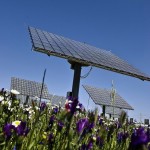
When negotiating with the developer of a big Imperial Valleysolar farm, San Diego Gas & Electricdidn’t just want green power. It also asked for local jobs.Specifically, it said the cutting-edge solar panels to be used in the project should be made in San Diego.
Thursday, SDG&E announced a solar farm it now has under contract will be the first customer for the biggest solar panel factory to be built in San Diego.The factory will employ 450 people once built. The solar farm, featuring 100,000 of the arrays, will take 250 workers two years to erect.“It’s quite exciting,” said San Diego Mayor Jerry Sanders, who was part of the effort to entice the solar factory to come to town.
Concentrix Solar, the company building the factory, hasn’t decided exactly where in San Diego the plant will go.
It said it decided to come here in part because of SDG&E’s efforts, and also to become part of a growing cluster of companies working to get energy from the sun and the wind.“There’s this incredible renewable energy ecosystem that’s building in San Diego,” said Clark Crawford, who heads the company’s local operations.
If all goes as planned, construction of the factory will begin this summer and take about 18 months. The factory is expected to cost about $100 million to build.
Construction of the factory won’t start until the solar farm is financed, and that financing depends on approval of a federal loan guarantee.Tenaska, the company building the solar farm, wouldn’t say how much it will cost, other than it’s several hundred million dollars.The company, based in Germany, is a subsidiary of Soitec, a French company.“It’s all about people,” said Soitec Chief Executive André-Jacques Auberton-Hervé. “You have the people here, the right environment.”
There are other solar panel makers here.Solar Innovations in Poway, which started in Pasadena, makes panels with a technology similar to Concentrix.Two other solar panel factories in town are owned by Japan’s Kyocera and Spain’s Siliken. In large part, they make panels destined for government projects that must have a certain amount of U.S. content.Tenaska, the Omaha, Neb., firm developing the Imperial Valley project, isn’t required to use American panels. It chose to do so because of urging from SDG&E.
SDG&E’s stance is a contrast with that of a sister company, Sempra Generation, which recently announced a deal with a Chinese company to supply the panels for a 150-megawatt solar farm it is building in the Arizona desert to supply Pacific Gas & Electric.
By state law, the utility and Sempra Generation are operated independently, and the different choices they made on technology and sourcing is a sign of their different priorities, said Jim Avery, who buys power for SDG&E.His priorities, he said, were to buy power affordably in a way that helps bring jobs to the region. He wouldn’t say what Sempra Generation’s priorities are.Concentrix panels are nothing like those you see on rooftops around town.
They’re more expensive, but make more electricity. They sit on steel poles and turn to follow the sun across the sky. And they use lenses to focus the sun’s rays on highly-efficient photovoltaic chips like those used on spacecraft.That means that shortly after the sun rises, they begin producing almost at full power. Production continues steadily into the late afternoon.That’s important to people like SDG&E’s Avery, who is responsible for making sure the region has all the electricity it needs.The 150-megawatt Imperial Valley farm will produce nearly full power late in the afternoon in the late summer, when SDG&E needs it the most, he said.“That’s a major benefit to us,” he said.
In a traditional photovoltaic solar farm, the panels don’t track the sun. In the late afternoon, he said, such a facility is producing less than half the electricity it does when the sun is highest in the sky.
At 150 megawatts, the solar farm will make enough power for about 55,000 households. It will be about a quarter the size of a typical new gas-fired power plant. Unlike such a power plant, the solar facility can’t make power at night, or when it’s cloudy.
It’s being developed by Tenaska on 1,057 acres of fallow farmland flanking Interstate 8. Tenaska is also building a nearby 130-megawatt farm on a former alfalfa farm along the U.S.-Mexico border.






